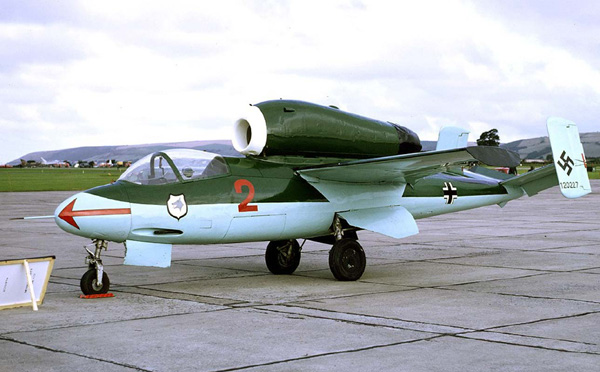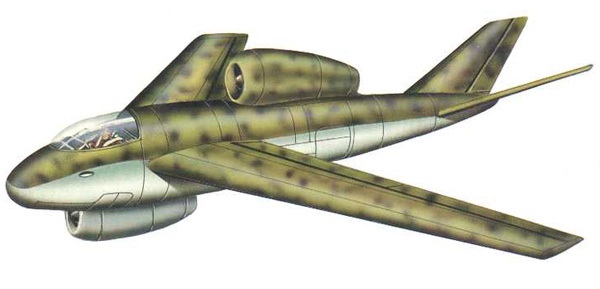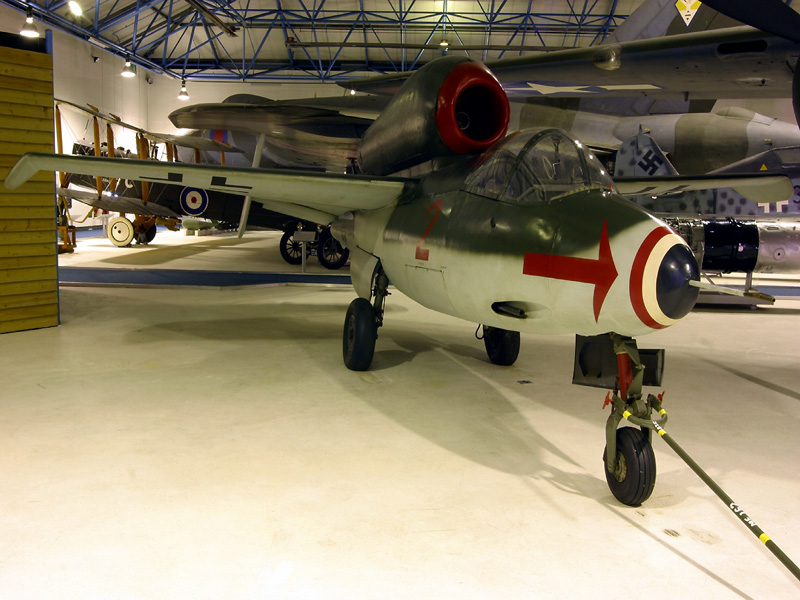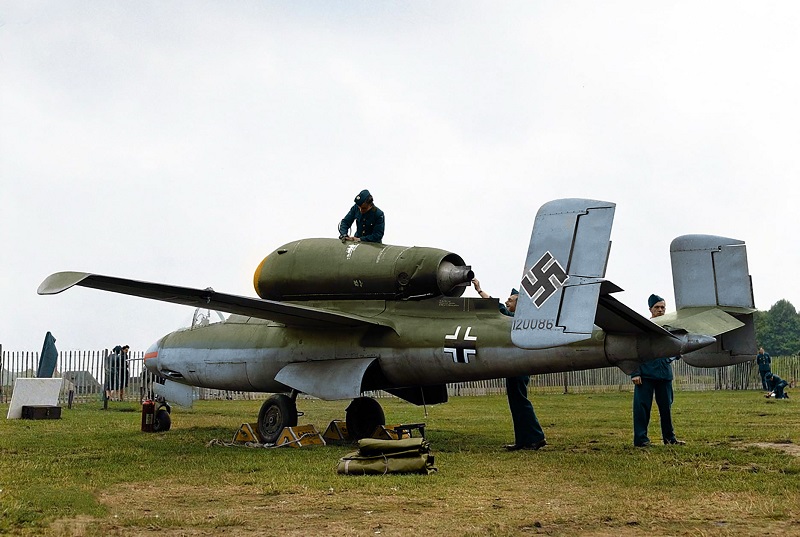
|
 |
Heinkel He 162 Salamander |
 |
 |
 |
 |
 |
|---|---|---|---|---|---|---|---|
 |
 |
 |
 |
 |
|||

|
|||
|
Although Ernst Heinkel named the He 162 the "Spatz" for Sparrow, the He 162 was mostly | |||
|
The turning point of the war for Germany was the defeat at Stalingrad in Russia and El Alamein in Egypt.1 From thereon, the Luftwaffe strained under the onslaught of the Allied air forces. No longer could Messerschmitt bf 109s and
Focke-Wulf 190s strike with impunity at Allied bombers formations as they flew deep into Germany. As the war progressed, escort fighters such as the
P-51 Mustang and
P-47 Thunderbolt could now escort bombers all the way into Germany. By January 1943, the Luftwaffe's operational strength was down to less than 4,000 aircraft and these were scattered along the Western, Mediterranean and Russian fronts.2 This limited the Luftwaffe's ability to stop the large Allied bombing raids on Germany which took its toll on armament, aircraft and particularly oil production facilities, bringing the once mighty Third Reich to its knees.
With the Third Reich crumbling from the barrage of Allied attacks, Albert Speer in a desperate effort, proposed building something new. The German Ministry of Aviation (Reichsluftfahrtministerium, or RLM) issued a proposal on September 8, 1944 to build a huge fleet of fast, agile, single-engine jet fighters. Scarce resources were already allocated to aircraft currently in production and aluminum and advanced alloys were in short supply. This required construction to be of nonstrategic materials, such as wood and steel, using semi-killed labor. Other requirements were: | |||
| • | Endurance of not less than 30 minutes. | |
| • | Takeoff distance within 500 m (1,640 ft.) | |
| • | Armament to consist of two Mk 108 30 mm cannons. | |
| • | Wing loading of not more than 200 kg/m2 (40 lbs/ft2.) | |
| • | The gross weight could be not more than 2,000 kg (4,400 lbs.) | |
| • | The top speed required was 750 km/hr (466 mph) at sea level. | |
| • | The airplane had to be ready for flight testing by December 1, 1944. | |
| • | The airplane had to be ready for production by January 1, 1945.3 |

| |||
| The Blohm & Voss P.211 was preferred but not selected, because of its complexity. | |||
|
Seven top firms that included Arado, Blohm & Voss, Fieseler, Focke-Wulf, Junkers, Heinkel and Messerschmitt were asked to view the proposal.4 Messerschmitt declined as they were already concentrating their efforts on the
Me 262. Blohm & Voss submitted a plan to build the P.211, a jet fighter with a nose air intake and engine buried in the fuselage. Heinkel, who had built the world’s first jet aircraft, the
He 178 and He 280, submitted a proposal to build the P.1073 which had already been envisioned by its special branch director, Siegfried Günter. The P.1073 had a tubular frame fuselage and wings, twin rudders and a retractable landing gear. It would be powered by the
BMW 003 axial-flow turbojet engine placed in a nacelle on top of the fuselage or below the cockpit.
The Blohm & Voss P.211 was preferred, because its engine didn’t block the pilot’s view to the rear, however, it was not accepted because of the complexity and time required to construct it. Time was running out for the hard-pressed Luftwaffe and in the end, Heinkel's proposal was accepted. It required fewer man-hours to build and had the best chance of meeting the required delivery dates. |

The original Heinkel P.1073 Heinkel was redesigned to fit the RLM's requirements.
The BMW 003 was a very troublesome engine when it first appeared and was installed on a Messerschmitt Me 262 prototype. Both engines failed during the test hop, but the plane managed to make it back to the airport powered by a backup piston-engine. The 003 suffered from the same problems as the Jumo 004, but after further development, the engine was finally ready for production. (After the war, the Russians reversed engineered the BMW 003 and developed it as the RD-20. The RD-20 powered the MiG-9, but the engine remained unreliable due to persistent flameouts.) Heinkel redesigned the P.1073 to fit the RLM's needs and the contract was awarded to Heinkel on October 19, 1944. Although Ernst Heinkel named the plane the Spatz for Sparrow, the He 162 was mostly known as the Salamander, because of the creature’s mythical ability to to live through fire. The prototype He-162 V1 emerged in 74 days and weighed 6,180 lbs., fully loaded. One third of the weight of the aircraft was wood for the airframe, wings, landing gear doors and nose cone. It had a high mounted wing straight wing with a forward swept trailing edge and a slight dihedral. Twin vertical stabilizers were installed with a high dihedral horizontal stabilizer placed to clear the jet exhaust. The flap system and landing gear were powered hydraulically from an engine-driven pump.5 The tricycle landing gear retracted into the fuselage (using Bf-109 main landing gear to simplify production) and was then lowered by springs compressed during retraction.6. It was also the first aircraft equipped with an ejection-seat as standard equipment. It was powered by an explosive cartridge that allowed the pilot to get clear the engine intake that was just aft of the cockpit.7

This underground facility was located in Hinterbrühl, Austria and produced 40-50 He 162s per month. |
|
The first prototype was flown on December 6, 1944 and reached a top speed of 522 mph. The aircraft handled well except for some longitudinal stability problems. The flight ended when one of the wooden main gear doors separated from the aircraft, due to defective bonding of the plywood. Four days later, the aircraft crashed after the wooden leading edge of the right wing delaminated, killing Heinkel’s chief test pilot, Flugkapitan Gotthard Peter. The wing failure was a result of defective bonding after the Goldschmitt Tego-Film factory was bombed and an alternative bonding agent was used. As it turned out the new bonding method was too acidic causing the wooden structure to deteriorate.8 Despite the crash, the He 162 program continued.
To correct longitudinal stability, Dr. Alexander Lippisch suggested adding small downward turning winglets on the wing tips. This corrected the problem and the winglets became known as Lippisch Ohren or Lippisch Ears. Other changes included: |
| • | The wing root trailing edges were turned downward to prevent tip stalling. | |
| • | Lead ballast was added in the nose rather than lengthening the fuselage to move the center of gravity forward. | |
| • | Small stall strips on the inboard leading edges were installed to improve stability and slow-speed handling. |
| Production aircraft were the He-162A-1 armed with a Mk 108 30 mm cannon and the He-162A-2 armed with a MG 151 20 mm cannon. Only a few A-1s were built because the nose structure was too light to handle the recoil of the 30 mm cannons.9 | ||

| ||
| Captured Heinkel He 162. | ||
|
The plane was to be flown by new pilots of the Hitler Youth, but as it turned out the plane was difficult to fly, requiring experienced pilots. Adolf Galland was opposed the Volksjager (Peoples' Fighter) project, on the grounds that it would drain valuable resources for the Me-262 and would be a death trap in inexperienced hands. However, Galland was overruled by Goering and Speer.10 Because of the extreme shortage of qualified pilots, only two fighter units, I./JG 1 and II./JG 1 managed to convert to the type before the end of hostilities. During February, 1945, 1st Gruppe of Jagdgeschwader 1 traded their Fw-190s for He-162s. By April, they had transferred to Leck, near the Danish border, where they continued to learn to operate the new fighter. The first claimed victory by an He-162 was on April 19, 1945. Feldwebel Kirchner was credited with shooting down a British aircraft, but he crashed before he could return to base. On April 20, Leutnant Rudolf Schmitt became the first and possibly only pilot to use the jet's ejection seat and survive. Ten days later, Unteroffizier Rechenbach was credited with a British aircraft and confirmed. In early May, Schmitt made the only confirmed kill by an He 162, shooting down a Hawker Tempest flown by Flight Officer M. Austin.11 |
||

| ||
| Heinkel He 162 A-2 120227, at RAF Museum London. | ||
|
The He-162's small fuel load and the engine's high fuel consumption gave it an endurance of around 30 minutes at sea level. It was said that it had good handling qualities and an excellent roll rate, but was difficult to handle at low airspeeds. Overenthusiastic use of the rudders to increase the jet’s already excellent roll rate could cause the tail section to fail, which is what happened to an unfortunate RAF test pilot during a post-war demonstration. In the traffic pattern, the throttle could not be reduced to idle until landing was assured. Once at idle, the engine took more than 20 seconds to spool up to full power (if it didn’t flame out) when the throttle was pushed up to initiate a go-around. The also jet had a bad tendency to settle as the flaps came up. |
||

| ||
| Heinkel He-162 (120086) on display during London's Thanksgiving week, September 14, 1945. | ||
|
Royal Navy test pilot Captain Eric Brown found the He-162 to be a very unforgiving airplane, but a very stable gun platform. The view from the cockpit was excellent, except for the critical six o’clock position, which was blocked by the engine.12 In Brown’s opinion, had the Luftwaffe been able to take the time to fully develop the He 162 with fully-trained pilots in the cockpits, the world's first operational single-engine jet fighter would have become a very formidable opponent. Like every other early jet aircraft, the He 162 was underpowered, but it had the worst safety record of all the early jet aircraft. This was in part to its being rushed into production before the prototypes were completed. It’s been said that the He 162 inflicted more casualties on German pilots than the enemy. Of the 65 factory pilots assigned to He 162s, only five were left at the end of the war. None were lost to combat—they died or crashed during ferry flights or learning to fly the aircraft.13 The top speed of the He 162 A-2 was 553 mph at sea level, and 562 mph at 19,500 ft. making it the fastest jet aircraft of the war. Its loaded weight was 6,180 lbs. A total of 116 He 162s were completed, and an additional 800 were in various stages of completion,14 but the actual amount of aircraft produced varies depending on the source. Only seven He-162s survived the war. |
||
| Specifications: | ||
|---|---|---|
| Heinkel He 162 | ||
| Dimensions: | ||
| Wing span: | 23 ft 7 in (7.20 m) | |
| Length: | 29 ft 8 in (9.05 m) | |
| Height: | 8 ft 6 in (2.60 m) | |
| Weights: | ||
| Empty: | 3,660 lb (1,660 kg) | |
| Max Takeoff: | 6,180 lb (2,800 kg) | |
| Performance: | ||
| Maximum Speed: | 562 mph (905 km/hr) at 6,000 m. | |
| Range: | 606 miles (975 km) | |
| Powerplant : |
1 × BMW 003E-1 or E-2 axial flow turbojet, 1,760 s.t. (7.85 kN) | |
| Armament: |
2 × 20 mm MG 151/20 autocannons with 120 rpg (He 162 A-2) or 2 × 30 mm MK 108 cannons with 50 rpg (He 162 A-0, A-1). | |
Endnotes:
|
1. Air Commodore H.A. Probert. The Rise and the Fall od the German Air Force. New York: St. Martin's Press, 1983. 201. 2. Ibid. 202. 3. J. Richard Smith & William Conway. Aircraft in Profile, Volume 9, The Heinkel He 162. Garden City, New York: Doubleday & Company, Inc., 1971. 238. 4. Ibid. 5. J.R. Smith, Antony L. Kay, E.J. Creek. German Aircraft of the Second World War. London: Putnam, 1985. 309. 6. J. Richard Smith & William Conway. 239. 7. Ibid. 241. 8. J.R. Smith, Antony L. Kay, E.J. Creek. German Aircraft of the Second World War. London: Putnam, 1985. 310. 9. Ray Wagner and Heinz Nowarra. German Combat Planes. Garden City, New York: Doubleday & Company, 1971. 378. 10. John Killen. The History of the Luffwaffe, 1915-1945. New York: Berkley Publishing Corp., 1967. 277-278. 11. Joachim Dressel and Manfred Greihl. The Luftwaffe Album, Fighters and Bombers of the German Air Force 1933-1945. New York: Sterling Publishing Company, 1997. 145. 12. Mark Carlson. “The Luftwaffe’s Wooden Wonder.” Aviation History July 2013. 43. 13. Ibid. 14. David Mondey. The Concise Guide to Axis Aircraft of World War II. New York: Smithmark Publishers, 1996. 94.
©Larry Dwyer. The Aviation History On-Line Museum.
All rights reserved. |